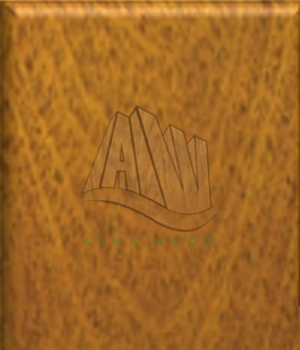DENSITY
The timber is a Heavy Hardwood with a density of 515-1,040 kg/m3 air dry.
NATURAL DURABILITY
The timber of merbau is classified as durable under exposed conditions. The classification is based on the standard graveyard tests of
untreated specimens of dimension 50 mm x 50 mm x 600 mm conducted at the Forest Research Institute Malaysia (FRIM). Two such tests were conducted on the species I.
palembanica. In the first series of such tests, the average service life for 14 test specimens was 5.5 years (Foxworthy & Woolley, 1930). In the second test,
the average service life for 60 specimens was 6 years (Jackson, 1965).
PRESERVATIVE TREATMENT
The timber is classified as very difficult to treat with preservatives.
TEXTURE
Texture is rather coarse but even, with interlocked grain.
STRENGTH PROPERTIES
The timber falls into Strength Group B (Engku, 1988b) or SG 4 (MS 544:Part 2:2001).
Strength Properties of Merbau
| Test Condition |
Modulus of Elasticity(MPa) |
Modulus of Rupture(MPa) |
Compression parallel to grain (MPa) |
Compression perpendicular to grain (MPa) |
Shear strength(MPa) |
| Green |
13,900 |
89.0 |
46.7 |
6.4 |
10.8 |
| Air dry |
15,400 |
116.0 |
58.2 |
9.2 |
12.5 |
MACHINING PROPERTIES
It is moderately easy to resaw and cross-cut when green but is slightly difficult when dried. Planing is easy to slightly difficult and the
planed surface is smooth in most cases except for slight picking up of grain on the radial face.
Machining Properties of Merbau
| Test Condition |
Sawing |
Planning |
Boring |
Turning |
|
|
Re Sawing |
Cross Cutting |
Ease of planing |
Quality of finish |
Ease of boring |
Quality of finish |
Ease of Turning |
Quality of finish |
| Green |
Moderately Easy |
Moderately Easy |
Easy |
Smooth |
Easy |
Smooth |
- |
- |
| Slightly difficult |
Slightly difficult |
Slightly difficult |
Smooth |
Easy |
Smooth |
Easy |
Smooth |
Nailing Property
Nailing property is rated as very poor.
Air drying
The timber seasons slowly without any degrade except for some powder-post-beetle attacks on the sapwood. 13 mm thick boards take approximately 4.5
months to air dry, while 38 mm thick boards take 6 months.
SHRINKAGE
Shrinkage values are particularly low. Radial shrinkage averaging 0.9% and tangential shrinkage averaging 1.6%.
DEFECTS
The logs are generally free from common defects. However, it has been reported that the timber is highly susceptible to powder-post beetle attacks (Menon, 1958).
USES
Merbau is a very attractive wood, with its growth ring figure and deep colour. The timber is suitable for interior finishing, panelling, mouldings,
office fittings, flooring (heavy traffic), superior joinery, cabinet-making, musical instruments, ornamental items and carvings. The timber is widely used for the
manufacture of reproduction antique furniture and strip flooring in the country. It is also suitable for heavy construction, power transmission poles, railway sleepers,
decking, columns (heavy duty), door and window frames and sills, fender supports, staircase (apron lining, rough bracket, baluster, balustrade, carriage, handrail, newel,
riser, stringer, tread, bullnose, round end and winder), heavy duty furniture, tool handles (impact) and pallets (heavy permanent type).
REFERENCES
Engku Abdul Rahman Chik. 1998b. Basic and Grade Stresses for Strength Groups of Malaysian Timbers. Malayan Forest Service Trade Leaflet No. 38. The Malaysian Timber
Industry Board and Forest Research Institute Malaysia, Kuala Lumpur. 13 pp.
Foxworthy, F.W. & Woolley, H. W. 1930. Durability of Malayan Timbers. Mal. For. Rec. No. 8.
Jackson, W.F. 1965. The Durability of Malayan Timbers. Malaysian Forest Servive Trade Leaflet No. 28.
Menon, K.D. 1958. Susceptibility of Commercial Species of Malayan Timbers to Powder-post Beetle Attack. Malaysian Forest Servive Trade Leaflet No. 27.
Menon, P.K.B. 1986. Uses of Some Malaysian Timbers. Revised by Lim, S. C. Timber Trade Leaflet No. 31. The Malaysian Timber Industry Board and Forest Research Institute Malaysia, Kuala Lumpur. 48 pp.
MS 544:Part 2:2001. Code of Practice for the Structural Use of Timber: Permissible Stress Design of Solid Timber.
Ser, C.S.1982. Malaysian Timbers - Merbau. Malaysian Forest Service Trade Leaflet No. 65. The Malaysian Timber Industry Board and Forest Research Institute Malaysia,
Kepong. 5 pp.
Wong, T.M. 1982. A Dictionary of Malaysian Timbers. Revised by Lim, S.C. & Chung, R.C.K. Malayan Forest Records No.30. Forest Research Institute Malaysia, Kuala Lumpur.
201 pp.

